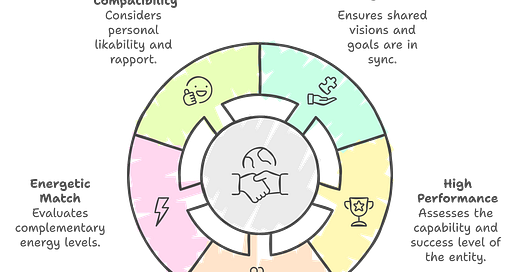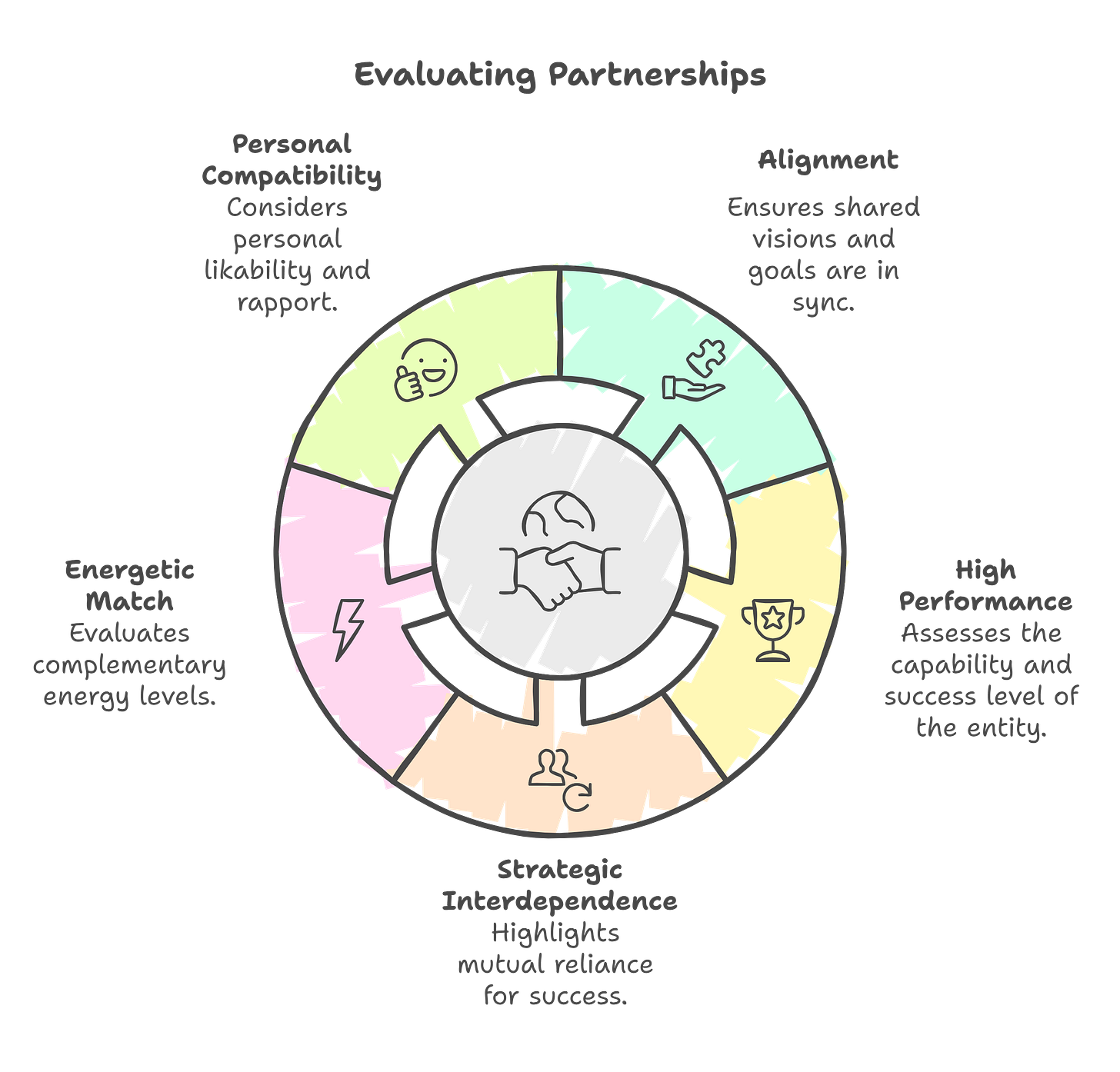My Partnership Framework for Choosing Strategic Business Partners
Navigating the world of business partnerships can be tricky. I've learned through experience that having a solid framework for choosing the right partners can save you a ton of headaches and missed opportunities. Let’s dive into my checklist for forming successful partnerships.
The Importance of Strategic Partnerships
Strategic partnerships are not just a buzzword; they’re the backbone of sustainable growth in business. When done right, these collaborations can amplify your strengths, fill gaps in expertise, and open doors to new opportunities. Think about it: when you team up with the right partner, you’re not just sharing resources; you’re combining visions, skills, and networks. This synergy can propel you further than you could go alone.
But here’s the catch: not all partnerships are created equal. Misaligned goals or values can lead to conflict and wasted time. That’s why a thoughtful approach to forming partnerships is crucial. You need to ensure that both parties are on the same page, share a common vision, and bring complementary strengths to the table.
Lessons from Failed Partnerships
Let’s be real—failed partnerships can be some of the most painful experiences in business. I’ve learned this the hard way. Each misstep taught me invaluable lessons about what to avoid. One of the biggest takeaways? Don’t rush into a partnership without evaluating the fundamentals.
Take the time to assess whether your potential partner’s priorities align with yours. I once partnered with someone whose vision was vastly different from mine. While I was ready to scale up and innovate, they were content to maintain the status quo. The result? Frustration on both sides, leading to a partnership that didn’t last.
Another lesson? Don’t ignore red flags. If something feels off during your initial interactions, trust your gut. Your instincts are often more reliable than any spreadsheet analysis. A partnership should feel like a natural extension of your business, not a forced fit.
Why You Need a Framework
So, why bother with a framework? Because it provides a clear roadmap for evaluating potential partnerships. A well-defined process can help you avoid the pitfalls of emotional decision-making. Instead of getting swept up in excitement or fear of missing out, you can objectively assess whether a partnership aligns with your strategic goals.
Having a framework allows you to focus on what truly matters: alignment, performance, and mutual benefit. It’s like having a GPS for your business relationships—keeping you on track and steering you clear of roadblocks.
The Five Key Areas of My Framework
I’ve boiled down my partnership evaluation process into five key areas. Each area is essential for ensuring a successful collaboration. Let’s dive into these categories and explore what they entail.
1. Alignment: Finding Common Ground
Alignment is the cornerstone of any successful partnership. It encompasses several subcategories that you need to evaluate carefully. If there’s no alignment, you might as well be speaking different languages.
Vision Alignment: Are We on the Same Path?
First up is vision alignment. Do both parties share a similar long-term vision for the partnership? This isn’t just about having the same goals; it’s about dreaming together. If you envision a future that looks drastically different from your partner's, it’s a red flag. You’ll end up pulling in opposite directions, and that’s a recipe for disaster.
Shared and Individual Goals
Next, let’s talk about goals—both shared and individual. It’s essential that you have common objectives for the partnership. But don’t forget about your personal ambitions. If your individual goals don’t align, you may find yourself at odds when it comes time to make decisions. For example, if you want to scale quickly while your partner prefers a more cautious approach, conflicts will arise.
Values Alignment: The Foundation of Partnership
Values are the bedrock of any relationship. If your core principles clash, it can lead to misunderstandings and burnout. I’ve seen partnerships crumble because one party prioritized profit over ethics, while the other was committed to integrity. Make sure your values align; otherwise, you're setting yourself up for conflict down the line.
Priorities: Are We in Sync?
When evaluating a potential partnership, aligning priorities is crucial. Simply put, if our priorities don’t match, we’re setting ourselves up for conflict. I’ve been in situations where I was all in, eager to push forward, while my partner viewed the project as just a side gig. This mismatch created tension and confusion.
It’s essential to have open conversations about what each party views as a priority. Ask yourself: Is this partnership a top priority for both of us? If not, you might find yourself carrying the weight alone, which can lead to frustration. Establishing shared priorities early on helps create a roadmap for success.
2. High Performance: Choosing the Right Players
Let’s get straight to the point: I only partner with high performers. Why? Because the energy and accountability of high achievers elevate the entire partnership. I’ve seen firsthand what happens when one party isn’t pulling their weight; it can be draining and demotivating.
Look for individuals or organizations that have a track record of success. Ask questions about their past achievements and how they handle challenges. It’s not just about skills; it’s about mindset and drive. A partner who is committed to high performance will push you to excel as well.
Remember, a strong partnership is like a high-performance team. You want every member to contribute, challenge each other, and celebrate successes together. If you’re stuck doing most of the work, it’s time to reassess.
3. Strategic Interdependence: Building Mutual Need
Strategic interdependence is all about creating a partnership where both parties need each other to thrive. If one party can easily walk away, the partnership is likely to suffer. This dependency creates a stronger bond and a shared commitment to success.
Think about how your strengths complement each other. What unique value does each party bring to the table? When both sides recognize their mutual need, it fosters collaboration and innovation. You’re not just working together; you’re building something that neither could achieve alone.
Ask yourself: How can we create a partnership that is not only beneficial but necessary for our growth? This mindset shifts the focus from transactional to transformational, paving the way for a more profound impact.
4. Energetic Match: The Power of Collective Energy
Energy is contagious. If you’re partnering with someone who has a low-energy vibe, it can sap your enthusiasm. Conversely, working with someone who radiates positivity and drive can elevate your own energy levels. That’s why finding an energetic match is non-negotiable.
Pay attention to how you feel during your interactions. Are you excited and engaged, or drained and disinterested? The right partner will inspire you to be your best self, fueling a collective energy that propels the partnership forward.
To gauge this, spend time together in different settings. Observe how you both respond to challenges and celebrate wins. A partnership should feel like a powerful collaboration, not a chore.
5. Do I Like the Person? The Human Element
At the end of the day, business is still about people. Do I like the person I’m partnering with? This may seem trivial, but trust me—it’s essential. If you don’t enjoy working with someone, the partnership will eventually falter.
Take the time to get to know each other beyond the business realm. Share experiences, values, and even personal stories. This connection can reveal whether you mesh well on a human level. It’s like a trial run for your partnership.
Trust your instincts. If something feels off, it’s worth exploring why. A solid partnership is built on mutual respect and camaraderie, and if that’s missing, it’s time to reconsider.
The Importance of Due Diligence
Before diving into a partnership, due diligence is essential. This isn’t just about checking references; it’s about understanding the person or organization’s reputation, values, and past behavior. Look beyond the surface and dig deeper.
Ask for case studies, client testimonials, or even conduct informal interviews with others who have worked with them. This insight can save you from potential pitfalls down the line.
Remember, partnerships are like marriages in many ways. You need to know who you’re getting involved with. Take your time; rushing into a partnership can lead to regrettable decisions.
Final Thoughts: My Checklist for Successful Partnerships
As I wrap up this discussion, let me share a quick checklist for evaluating potential partnerships:
1. Alignment: Are our visions, goals, values, and priorities in sync?
2. High Performance: Is this person or organization a high performer?
3. Strategic Interdependence: Do we need each other for mutual success?
4. Energetic Match: Does our energy complement each other?
5. Do I Like the Person? Can I hang out with this person?
By following this framework, you can avoid the headaches and heartaches that come from misaligned partnerships. Trust me; it’s worth the effort. Choose wisely, and you’ll create thriving partnerships that elevate your business to new heights.







